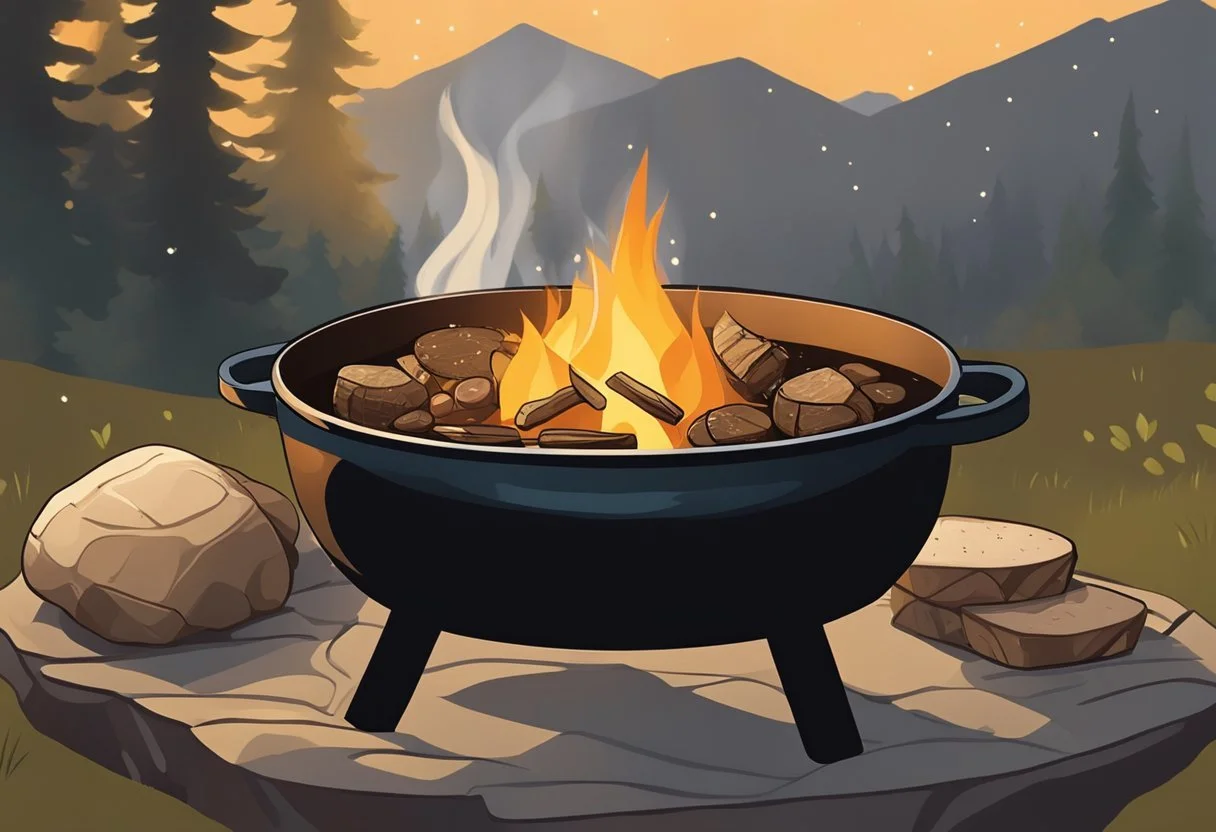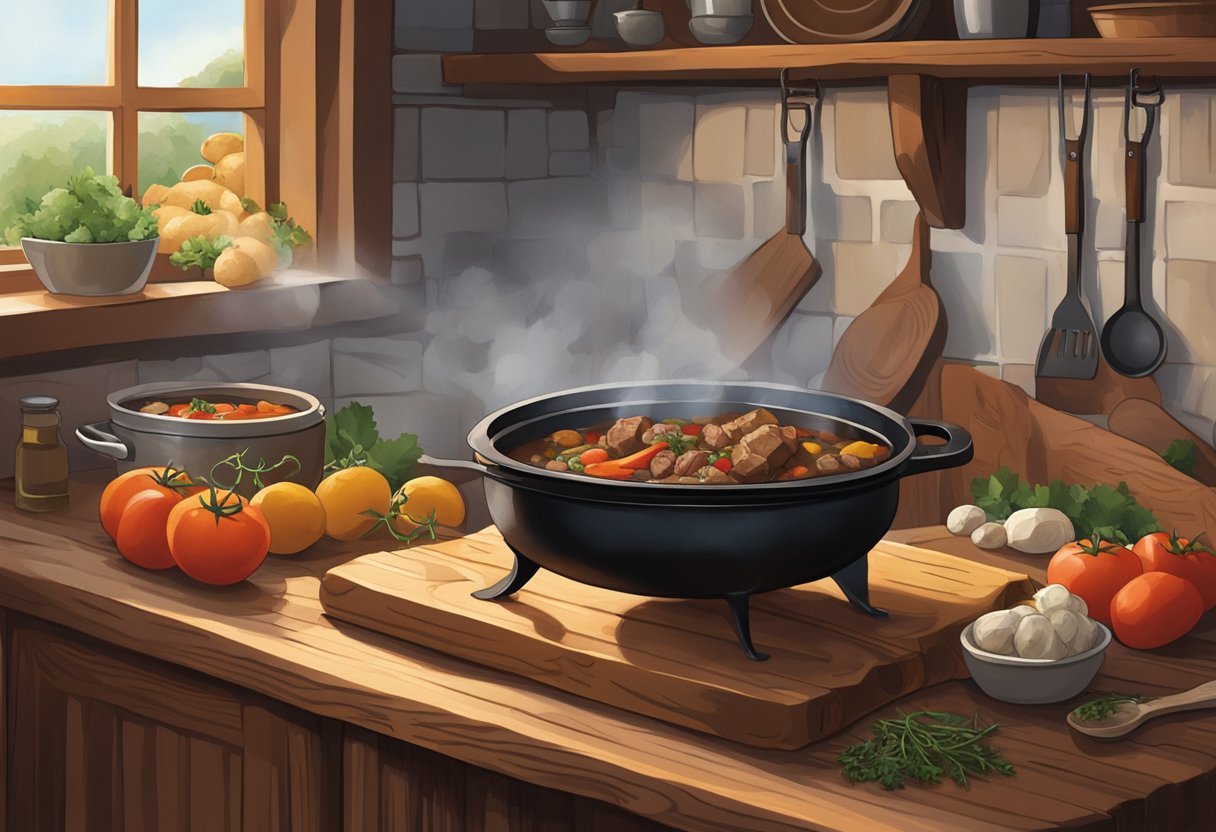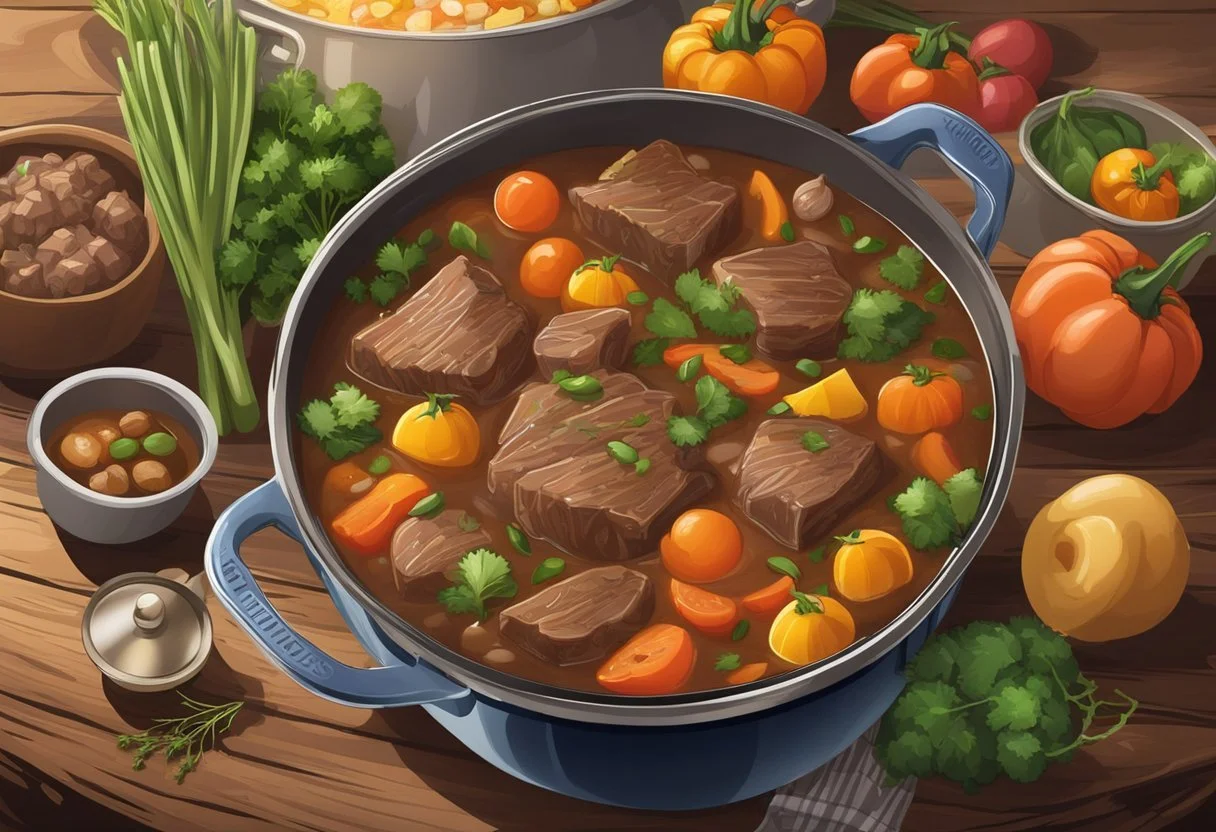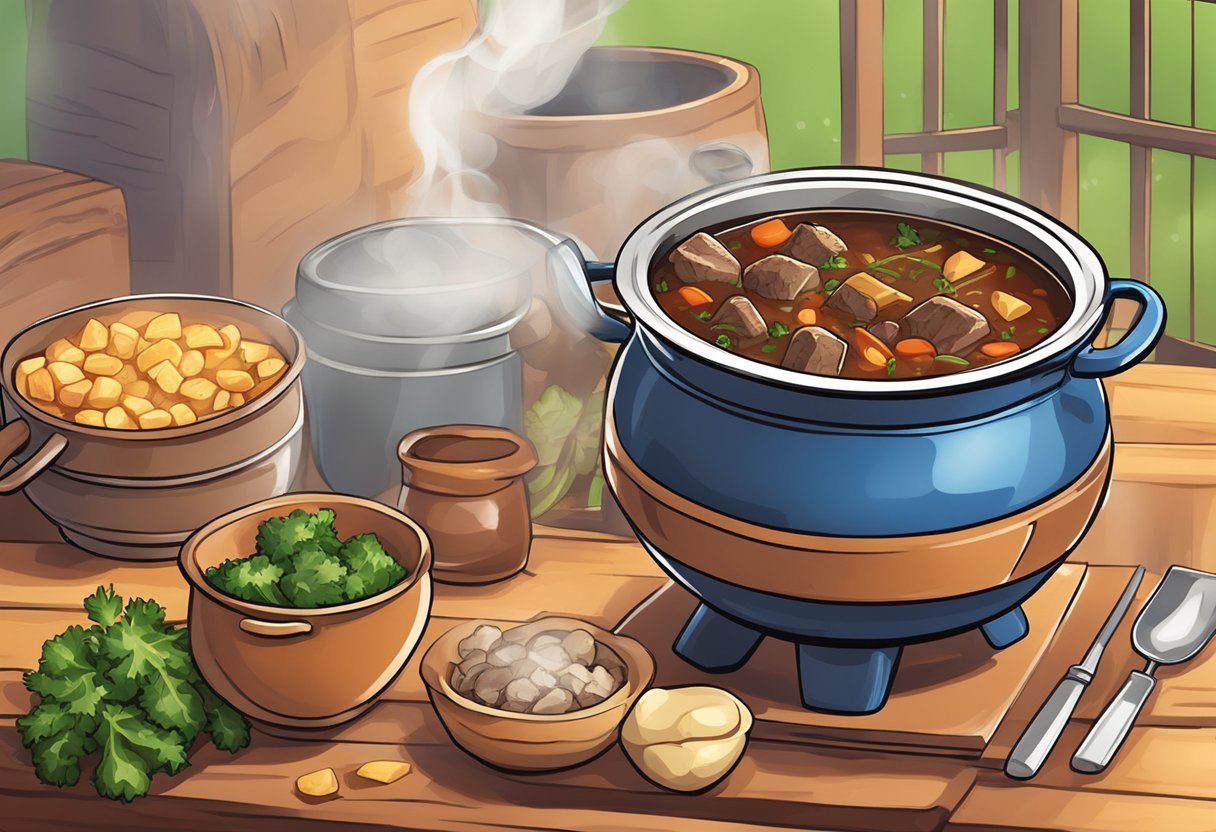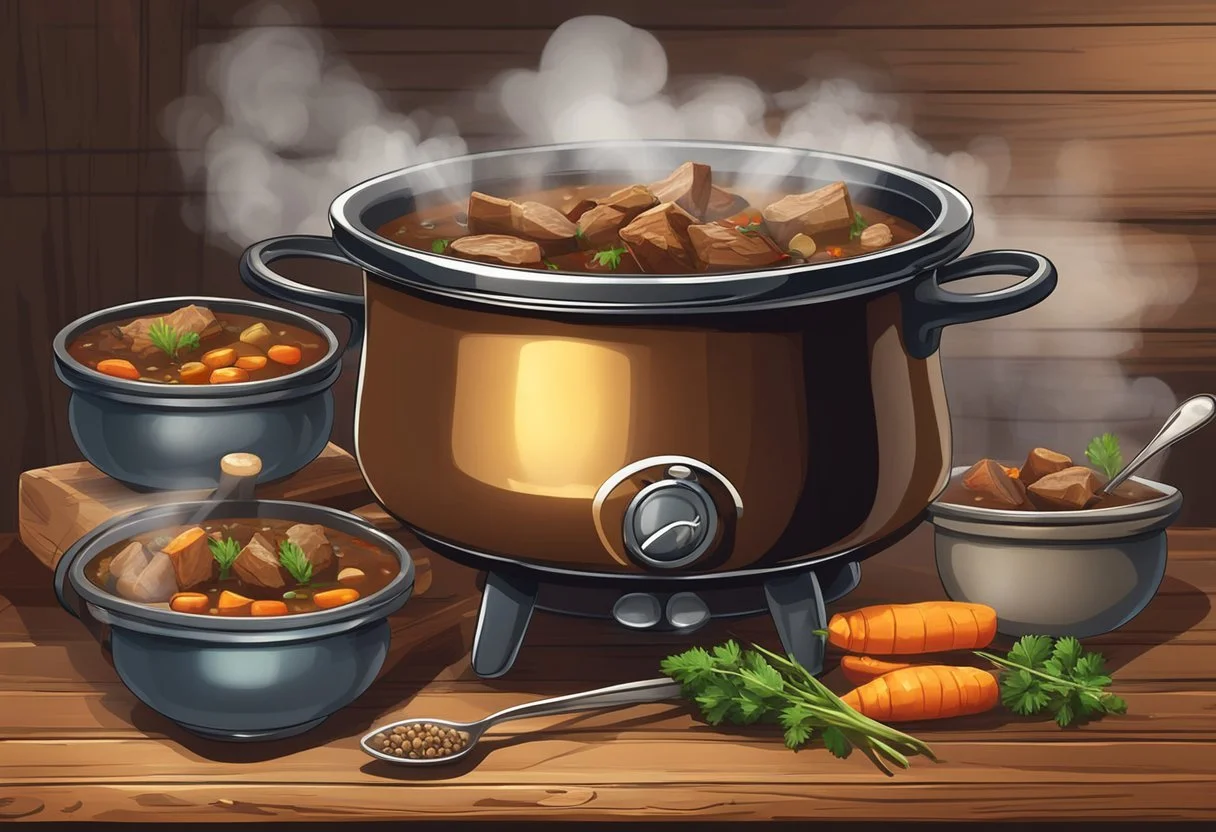Texas Cowboy Beef Stew
Hearty Comfort Food for Chilly Days
Discover > Truly Texan > Texas Cowboy Beef Stew
Texas Cowboy Beef Stew is a hearty and flavorful dish that perfectly captures the essence of the Lone Star State. With its robust ingredients and rich history, this stew is sure to satisfy your cravings for a wholesome, home-cooked meal. Steeped in cowboy culture, it pays tribute to the culinary traditions of Texan ranchers while providing a filling and comforting dish fit for dinner tables worldwide.
This recipe brings together tender chunks of beef, a medley of vegetables, and a blend of spices to create a one-pot meal that's both nourishing and delicious. Taking inspiration from the rugged lifestyle of cowboys working on cattle ranches, Cowboy Stew showcases the perfect balance of flavors and textures, ensuring each spoonful is a delightful experience.
Whether you're a seasoned home cook or a novice trying your hand at Texan cuisine, preparing the cowboy stew recipe is not that difficult and very rewarding. The rich heritage behind this dish combined with its bold flavors and comforting warmth make it an ideal meal for any occasion. Embrace the spirit of Texas and indulge in a bowl of this remarkable cowboy stew recipe.
History and Cultural Significance
In the vast expanse of Texas, the cowboy lifestyle took root and thrived, giving birth to a rich and diverse culture that is celebrated to this day. One key aspect of the cowboy culture is their culinary traditions, and among them, the cowboy stew holds a special place. It is a hearty comfort food that has evolved over time, boasting a unique mix of flavors that capture the essence of cowboy cuisine.
Originating in the late 19th century, the stew was designed to be a practical and convenient one-pot meal for cowboys on long cattle drives. With limited resources available on the range, cowboys needed a filling and nutritious dish that could be easily prepared over an open fire. Cowboy stew was born to meet these demands, and its delicious taste quickly established it as a staple in the cowboy diet.
Consisting of beef, vegetables, and a flavorful broth, the stew provided cowboys with the essential nutrients they needed to maintain their energy levels during back-breaking work. The ingredients for the stew were readily available and easily preserved, making it an ideal choice for long journeys. Beef, being in abundant supply, became the primary protein source in the dish, with vegetables providing essential vitamins and minerals.
Today, the cowboy stew recipe carries significant cultural weight, as it symbolizes the strength, resilience, and resourcefulness of the cowboy tradition. It also represents the strong sense of community that existed among cowboys, as the stew was often shared among the entire crew. This act of communal eating reinforces the value of fellowship and camaraderie that is still celebrated in modern Texas culture.
With its robust flavors and deep roots in the cowboy community, cowboy stew recipe continues to be cherished not only as a delicious comfort food but also as a testament to the rich history and enduring cultural legacy of the Lone Star State.
Essential Ingredients for Authentic Flavor
Meats Selection
To make cowboy stew authentically, selecting the right meats is crucial. Start with a combination of beef, preferably chuck roast or stew meat, and smoked sausage (such as kielbasa sausage or any similar high-quality sausage). You may add ground beef or bacon for extra protein and fat, lending a richer flavor and mouthfeel to the stew.
Vegetables and Beans
A variety of vegetables adds flavor, color, and texture to beef stew. Classic choices include onion, garlic, corn, diced tomatoes, and potatoes. Incorporating beans adds a depth of flavor and heartiness. Pinto beans (how long does pinto beans last?) are the traditional choice, but other types of beans or even mixed vegetables can be used. For added heat and Southwest flair, green chilies, whole kernel corn and frozen mixed vegetables are excellent additions. Frozen mixed vegetables and canned diced tomatoes also can be added near the end of cooking.
Spices and Seasonings
Creating an authentic flavor profile calls for a harmonious blend of spices and seasonings. Cowboy stew typically features a combination of cumin, chili powder, salt, pepper, and Southwestern spices. Don't be afraid to experiment with smoked paprika, (how long does smoked paprika last?) paprika, ground cumin, and black pepper to elevate the taste of your stew. Adjust the levels of spices to suit your taste buds and achieve a perfect balance.
If you can’t find these ingredients in your local markets, you can order cumin, chili powder, salt, Southwestern spices, smoked paprika, paprika, and black pepper online!
Broths and Liquids
The key to a flavorful and hearty stew is the choice of broths and liquids. A solid base starts with beef broth (how long does beef broth last?). However, for variation, you can opt for chicken broth (how long does chicken broth last?), water, or even a combination. The goal is to achieve a savory broth that complements the other ingredients in the stew, allowing their flavors to meld and develop. Diced tomatoes or Rotel offer additional liquids and acidity. Diced tomatoes add a little acidity to balance the flavor.
Make your life easier by ordering beef broth, or chicken broth, and diced tomatoes online; it's just a few clicks away!
Additional Enhancements
To make cowboy stew even more interesting, consider the following accompaniments and finishes. Serve the stew with a side of warm cornbread to make the meal even more satisfying. Some final touches to consider are a dollop of sour cream, a sprinkle of shredded cheese, or a few slices of green chile peppers. These additions not only enrich the dish but make cowboy stew more visually appealing to impress your guests.
Step-by-Step Cooking Instructions
Preparation Techniques
To start with this easy and comforting cowboy stew recipe, the first step is to gather all the ingredients and prepare them accordingly. This includes:
Chopping vegetables such as onions, carrots, celery, potatoes and diced tomatoes
Slicing the beef into cubes, and seasoning with salt, pepper and chili powder.
During the preparation stage, make sure to organize your ingredients to ensure a smooth cooking process. Keep your chopped vegetables minced garlic and seasoned beef on separate plates, ready to be cooked.
Cooking Methods
The best way to cook cowboy stew is by using a slow cooker, a Dutch oven, or a crockpot. Follow these steps for each cooking method:
Browning: In each respective cooking vessel, heat some oil on medium-high heat, and brown the beef cubes on all sides. Work in batches if necessary to avoid overcrowding the pan. Remove the beef and set aside.
Sautéing: Add the chopped onions, carrots, diced tomatoes, and celery to the pot, cooking until they start to soften.
Stew Base: Add back the browned beef along with any other required ingredients such as tomatoes, beef broth, or seasoning according to the recipe and chili powder. Be sure to scrape the bottom of the pot for those flavorful cooked bits, which will dissolve in the beef broth.
Simmering: Boil until the beef broth simmers, and then reduce the heat to achieve a gentle simmer. Allow the stew to cook until the beef is tender, the beef broth reduces and the flavors meld together. The cooking time will depend on the chosen cooking method.
Dutch oven: Simmer for about 2 hours on low heat, covered
Slow cooker: Cook on low for 6-8 hours or high for 3-4 hours
Crockpot: Cook on low for 7-9 hours or high for 4-5 hours
Avoid the crowds and shop for a Dutch oven or crockpot online from the comfort of your home!
Final Touches and Serving
When the Texas cowboy stew is cooked, make any necessary seasoning adjustments with salt and pepper. For additional flavor, you may consider adding a splash of hot sauce (how long does hot sauce last?) or a handful of chopped fresh herbs, such as cilantro or parsley.
To serve, thicken then beef broth if required and ladle the stew into bowls along with kernel corn and accompany it with a side of bread, cornbread muffins, garlic bread, or tortilla chips. This enhances the overall texture and provides a delightful way to soak up any remaining stew in the bowl. Enjoy this warm and satisfying comfort food with your family and friends.
Variations and Substitutes
Meat Alternatives
For those looking for a healthy twist on the classic cowboy stew, there are several meat alternatives available. For instance, ground beef, ground turkey and ground chicken can be used as suitable substitutes to the traditional beef. Both ground turkey and ground chicken offer a lighter, less fatty alternative but still retain a hearty, satisfying flavor. On the other hand, using lean ground beef can help reduce the fat content in the stew without sacrificing the authentic taste.
Vegetarian and Vegan Options
Introducing vegetarian and vegan options for Texas cowboy stew can be a simple task with a few clever adjustments. Replacing the meat with hearty vegetables such as potatoes, carrots, squash and ranch style beans can provide delicious results. Additionally, plant-based protein sources, like a variety of beans, can offer the needed texture and nutrition. Replace the beef broth with a vegetable broth (how long does vegetable broth last?) to ensure that the stew remains entirely vegetarian or vegan.
Different Cooking Styles
The traditional way to cook Texas cowboy stew is on the stovetop, using a large Dutch oven. However, not everyone has the time or desire to conduct such a hands-on process. Fortunately, there are alternative, no-fuss cooking methods that can still produce delicious results.
Crock Pot: This method requires minimal effort. Add all ingredients into the crock pot and let it cook throughout the day at a low temperature. This slow cooking technique allows the flavors to meld beautifully, creating a mouth-watering stew.
Slow Cooker: Similar to the crock pot, using a slow cooker requires little attention. The ingredients can be combined and left to cook on a low setting for several hours. This approach is perfect for those busy fall and winter days when comfort food is desired but time is in short supply.
Regardless of the variations, substitutions, and cooking methods chosen, Texas cowboy stew remains a versatile and satisfying dish.
Serving and Pairings
When it comes to serving Texas Cowboy Stew, there are various accompaniments that can enhance its flavors and textures. In this section, we will explore some common and delicious pairings that you might want to consider when serving this hearty meal.
One popular choice to serve with Cowboy Stew is bread. A great option is cornbread, which complements the flavors of the stew and adds a unique, satisfying texture. Another suitable pairing is garlic bread, which elevates the meal by adding a burst of savory garlic flavor.
If you're looking for something a bit lighter, try pairing the stew with tortilla chips (how long do tortilla chips last?). They can be used to scoop up the rich stew or as a crunchy topping. This option is ideal for those who enjoy a bit of a Tex-Mex twist.
A dollop of sour cream can be used as a garnish for the stew, adding a touch of creaminess and tanginess that counters the heat of the dish. This simple addition can enhance the soup pot overall flavor profile.
Cowboy Stew is often enjoyed as a one-pot meal, making it an excellent option for those seeking a fuss-free, hearty dinner. To turn it into a more substantial spread, consider serving the stew alongside a salad, rice, or steamed vegetables.
To sum up, here are some fantastic pairing options for Texas Cowboy Stew:
Bread: Cornbread or Garlic bread
Chips: Tortilla chips
Garnish: Sour cream
Sides: Salad, rice, or steamed vegetables
Choose the accompaniments that best suit your preferences and enjoy this delicious, comforting meal with family and friends.
Tips for Storing and Reheating
When it comes to preserving the delicious flavor and texture of your cowboy stew, proper storage and reheating techniques are essential. Follow these simple tips to maintain the integrity of your dish and enjoy tasty leftovers.
Storing
Cool it down: Allow your freshly cooked stew to cool down at room temperature for about 20-30 minutes before storing. This prevents condensation from forming inside the storage container, which could lead to spoilage.
Use airtight containers: Transfer your stew into airtight containers before placing them in the refrigerator or freezer. This prevents air exposure and helps retain the dish's flavor and moisture.
Label and date: Don't forget to label your containers with the name of the dish and the date it was prepared. This helps prevent any confusion in the future and ensures proper food rotation.
Refrigerator or freezer: If you plan to consume the stew within 3-4 days, store it in the refrigerator. For long-term storage (up to 3 months), opt for the freezer.
Refrigerated leftovers: For stew that's been stored in the refrigerator, reheat it on medium heat in a saucepan on the stovetop, stirring occasionally, until it reaches an internal temperature of 165°F (74°C). Avoid using high heat, as it can overcook the meat and make it tough.
Frozen stew: If you've frozen your stew, it's best to thaw it in the refrigerator overnight before reheating. Thawing at room temperature is not recommended, as it creates an environment conducive to bacterial growth. Once thawed, follow the same stovetop instructions for refrigerated leftovers.
Microwave: If you're short on time, reheating stew in the microwave can suffice. Transfer the stew to a microwave-safe dish, cover with a vented microwave cover, and heat on medium power, stirring occasionally, for even heating. Be sure to check the internal temperature of the stew to ensure it reaches 165°F (74°C).
By adhering to these guidelines for storage and reheating, you'll be well-equipped to enjoy savory and scrumptious cowboy stew leftovers.
Nutritional Information
Cowboy stew is a hearty and flavorful dish that provides a good source of essential nutrients. It is particularly rich in protein and fat, which contribute to overall health when consumed in moderation.
A typical serving of this stew (approximately 1 cup) will provide around 30 grams of protein and 10-15 grams of fat. The protein content is mainly derived from the beef, while the fat content comes from the combination of beef and added cooking oil.
Moreover, the stew also contains various essential vitamins and minerals, such as iron, zinc, and B vitamins. These micronutrients play important roles in maintaining optimal health and should not be overlooked when considering the nutritional profile of this dish.
Cowboy stew contains a moderate amount of carbohydrates, depending on the choice of vegetables and additional ingredients used. It is worth noting that adding more root vegetables, such as potatoes and carrots, will increase the carbohydrate content of the stew. However, opting for a more vegetable-rich version can result in lower carbohydrate content and potentially lower calorie count.
In summary, cowboy stew is a nourishing meal option that provides:
High levels of protein
Moderate levels of fat
Selected vitamins and minerals such as iron, zinc, and B vitamins
A variable amount of carbohydrates based on ingredient choices
It is essential to enjoy this flavorful dish in moderation and to balance it with other food groups to maintain a healthy and balanced diet.
Feedback and Community
Comment Section for Readers
Our Texas Beef Stew community thrives on feedback from our readers. We encourage you to share your thoughts and experiences in the comment section below the recipe. Whether you have rave reviews, improvement suggestions, or just want to share your thoughts on this classic comfort food, we'd love to hear from you. Here are a few things to consider when leaving a comment:
Rate the recipe: Out of five stars, how would you rate this dish?
Servings: How many servings did you make, and were there any adjustments needed to suit your household?
Questions: If you have any doubts or questions regarding the recipe itself, feel free to ask.
Sharing Variations and Tips
The diversity and adaptability of this Texas Beef Stew recipe create a unique opportunity for our community to contribute their variations and tips. We encourage you to share these insights in the comment section. Your suggestions and discoveries will make this recipe and community a more inclusive and enriching experience for all. Here are some thought starters:
Substitutions: Did you try any ingredient substitutions that worked out well for you?
Healthier alternatives: Were you able to convert this comfort food dish into a healthier version?
Cooking methods: Did you experiment with any different cooking methods or techniques which enhanced the flavors or textures?
Try these tips: If you have any personal tips and tricks that you have discovered while preparing this dish, please share!
By engaging in our Feedback and Community sections, you help enhance a supportive and dynamic environment. We appreciate all contributions that deepen the collective culinary knowledge and create a more enjoyable cooking experience for all readers.
Conclusion and Final Thoughts
The cowboy stew recipe recipe not only enriches the culinary world but also provides a delightful option for those seeking a hearty meal. With a rich blend of flavors, it's a dish that truly reflects the spirit of Texas.
It is essential to approach the recipe with confidence instilled by the knowledge gained from mastering each step. Accurate measurements, proper preparation, and attention to detail will ensure a successful outcome.
For easy organization and navigation, the key components of the recipe are presented as follows:
Ingredients: A comprehensive list that includes quality cuts of beef, fresh vegetables, and various spices to enhance the overall flavor.
Instructions: Detailed, step-by-step guidelines to ensure a smooth cooking process.
Serving Suggestions: Ideas for pairing the dish with complementary side dishes and beverages.
Texas cowboy stew is a satisfying dish, whether enjoyed by a lone cowboy or shared amongst a family. With determination, anyone can create this savory, sumptuous meal. As a final note, remember that practice makes perfect; continue refining your technique to achieve the best results on your journey toward culinary excellence with this easy cowboy stew recipe.

